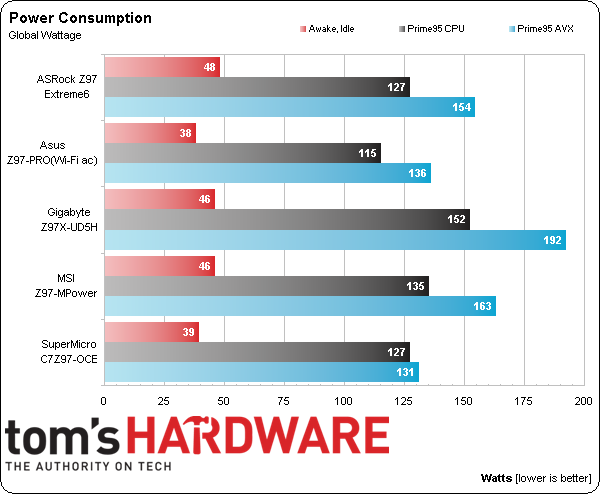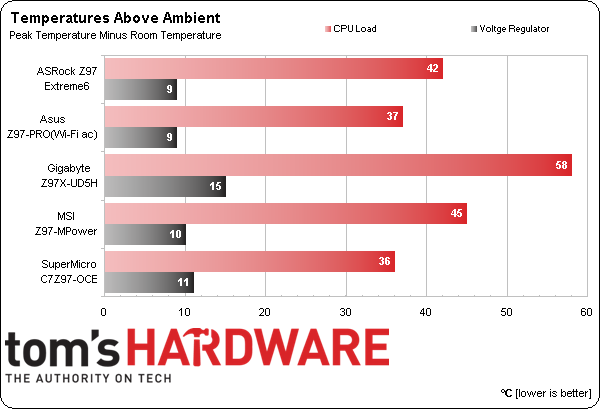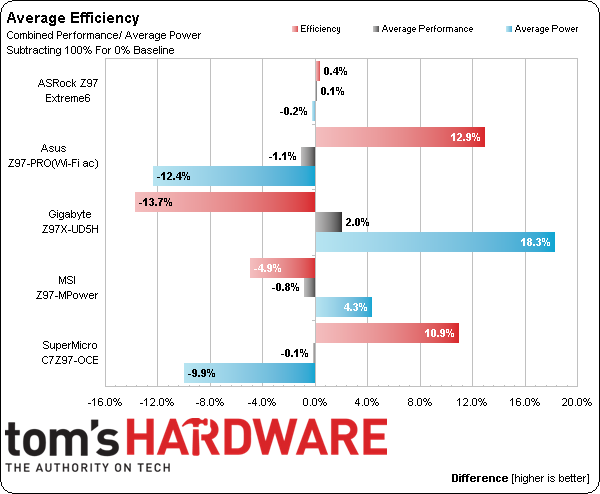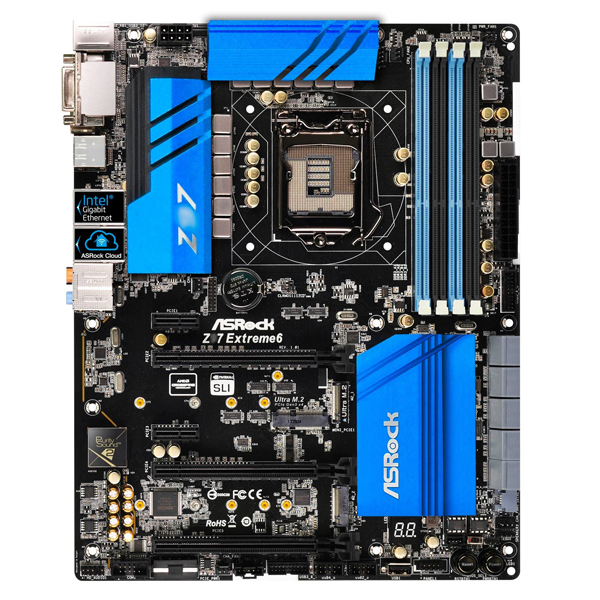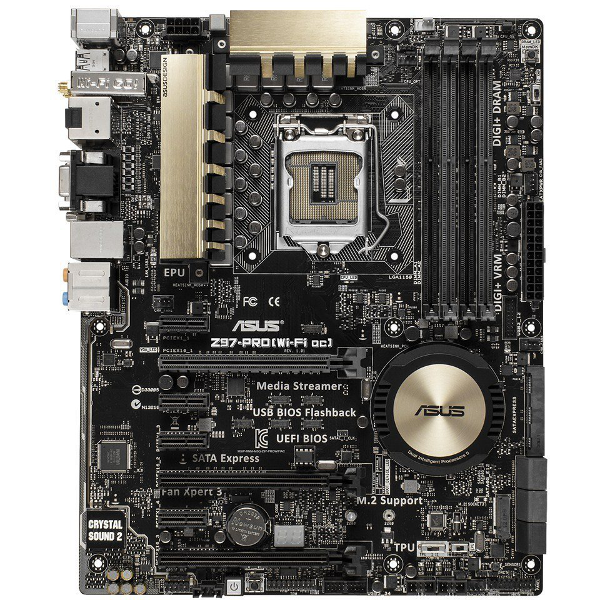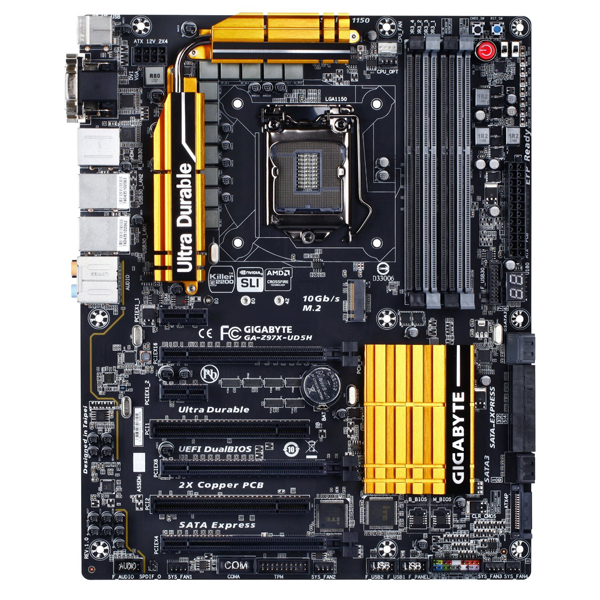Five Z97 Express Motherboards, $160 To $220, Reviewed
Intel’s “mainstream” socket continues to spawn enthusiast parts with the company’s fastest-ever gaming-oriented CPU. You’ll probably want a feature-packed motherboard for that, and five companies stepped up to show off the best of the sub-$220 segment.
Results: Power, Heat and Efficiency
We manually enable all of Intel’s C-states before running our performance benchmarks and power tests. However, Gigabyte’s Z97X-UD5H imposes this CPU's top Turbo Boost ratio whenever any load is applied. We see the platform jump from a reasonable 46 W with its cores mostly idle (power settings working) to a more extreme 192 W fully loaded with eight threads of AVX-optimized Prime95.
The above result from Gigabyte's Z97X-UD5H is a perfect example of what happens when a motherboard forces the top Turbo Boost ratio with all cores utilized, and it’s also the perfect example of why this CPU is supposed to drop from 4.4 GHz to 4.0 GHz at that load level. Intel calls this an 88 W processor!
Anyone who wants to argue against my suggestion that forced Turbo Boost ratios represent overclocking need only look at the temperature results from Gigabyte’s Z97X-UD5H, above. Thanks for making my point guys!
Now, let's play devil's advocate. What did Gigabyte’s overclock yield? Per our measurements, a 2% gain in performance with a 12% loss in efficiency. That loss in efficiency boosts Asus' Z97-Pro(Wi-Fi ac) to the top of this chart.
Get Tom's Hardware's best news and in-depth reviews, straight to your inbox.
Current page: Results: Power, Heat and Efficiency
Prev Page Results: File Compression Next Page Results: Overclocking-
Memnarchon At this price Asus could send a ROG product (Maximus VII Hero). I wonder why they choose to send the Z97-Pro instead...Reply -
bigshootr8 ReplyAt this price Asus could send a ROG product (Maximus VII Hero). I wonder why they choose to send the Z97-Pro instead...
My thoughts you can find the hero board within that price range quite easy. http://pcpartpicker.com/part/asus-motherboard-maximusviihero -
Drejeck I'd like some ITX Z97 and H97 with M.2 reviewed.Reply
I'm buying the Asus Z97i-plus because it just mount a 2x M.2 2280 and 2260, and all other connectivity goodness, uninterested in overclocking unless the broadwell i5 K consume less than 90W :D -
mapesdhs I recently bought a Z97I-Plus. Being so used to EATX boards as of late, I was a tadReply
stunned at how tiny even the packing box is. :D Just pairing it up with a G3258
initially to see how it behaves. Pondering a GTX 750 Ti, but kinda hoping NVIDIA
will release a newer version in Sept.
Ian.
-
Crashman Reply
They probably wanted to win based on features for the money? We know that the Wi-Fi ac has A $50 WI-FI CONTROLLER, what does the Hero add that's worth $50?13953852 said:At this price Asus could send a ROG product (Maximus VII Hero). I wonder why they choose to send the Z97-Pro instead...
-
lp231 The Asus ROG boards have a red line that lights up showing the audio path through it's build in LEDs, but the mainstream Z97 don't. I had a chance to take a look at one of the Asus Z97 board and took my phone's flash to shine in on it. The color was somewhat yellowish green and it looks really nice.Reply -
g-unit1111 I have a Z97 Extreme 6, it's a very nice board and it's definitely worthy of the approval award.Reply -
TechyInAZ Nice boards!! I love the gigabyte model but I like asus more because yellow heatsinks just don't fit in my opinion.Reply -
Memnarchon Reply
Hello. I think there are more reasons to buy a ROG product, instead of a Wi-Fi controller...13956156 said:
They probably wanted to win based on features for the money? We know that the Wi-Fi ac has A $50 WI-FI CONTROLLER, what does the Hero add that's worth $50?13953852 said:At this price Asus could send a ROG product (Maximus VII Hero). I wonder why they choose to send the Z97-Pro instead...
Better audio quality.
Better MOF-SETs.
Better inductors.
ROG BIOS.
Generally ROG boards have better quality parts.
But in the end we need the reviewers (like you) to review as many products as they can, so we can see the performance difference between them.
